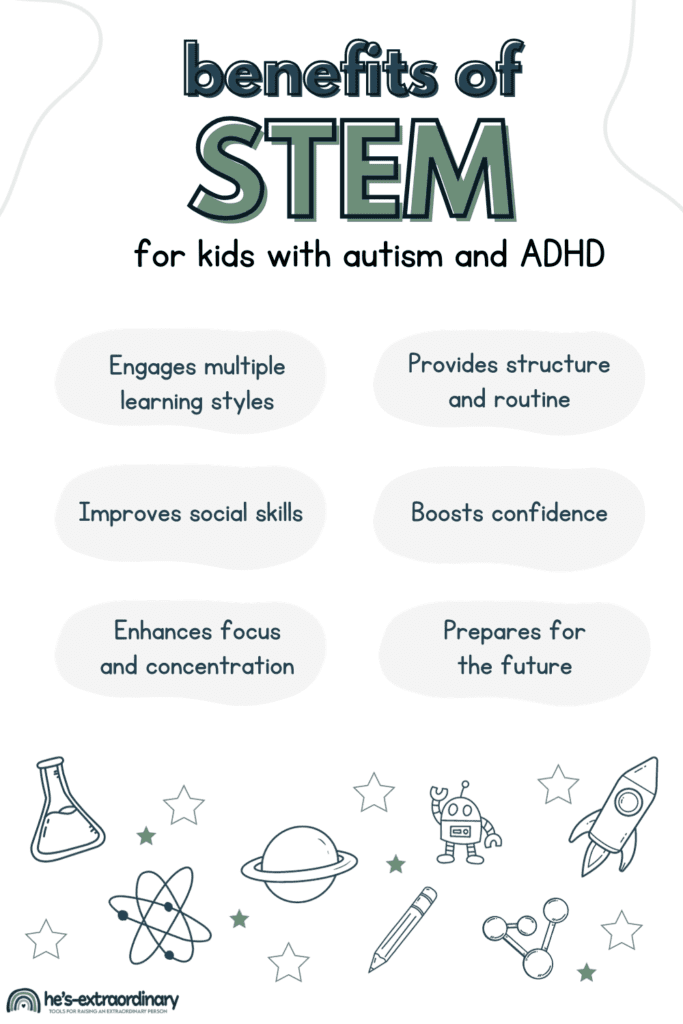Neurodiversity Meets Innovation: The Benefits of STEM for Kids with ADHD and Autism
What’s inside this article: A look at six benefits of STEM for kids with autism and ADHD, plus six STEM activities to get you started.
Disclaimer: This post contains affiliate links.
STEM is an acronym that neatly packages Science, Technology, Engineering, and Mathematics under one umbrella.
It’s the backbone of many marvels around us – from the bridges that connect cities, the software that simplifies tasks, to the space probes that unravel cosmic secrets.
But here’s something you might not know: STEM isn’t reserved just for budding scientists or techies. It’s got a wealth of benefits for kids with Autism and ADHD.
Intrigued? Let’s dive deeper into the whys and hows.
The Benefits of STEM for Kids with ADHD and Autism
For many kids with autism and ADHD, the traditional classroom environment can often feel overwhelming, confusing, or even tedious.
However, STEM activities’ experiential, hands-on nature can offer a refreshing alternative that caters to their unique learning styles.
Here’s how:
Engaging Multiple Learning Styles:
Studies show that 50 to 70 percent of children are inclined toward more than one learning style. We call these children “multimodal learners.”
They often do well when we present them with information in several different forms that complement each other.
And, since STEM activities are hands-on, their tactile and visual nature makes them more engaging and effective. This is beneficial for kids who struggle with traditional lecture-style teaching methods.
Enhancing Focus and Concentration:
Activities that involve building or problem-solving, such as coding or engineering tasks, require focus.
For children with ADHD, these activities can help channel their energy into productive tasks and train them to sustain attention over more extended periods.
Improving Social Skills:
Many STEM projects are collaborative. Kids with autism often benefit from structured social interactions with clear roles and expectations.
Working together on a STEM project provides just that. It’s an excellent opportunity to help them practice and improve their social skills while learning something new, too.
Have your autistic child work collaboratively with an adult or an older child who can guide and encourage them while also interacting with them positively.
Boosting Confidence:
Building confidence in our children is crucial for their overall development and well-being in a world that constantly challenges them. Success in STEM activities can provide a significant boost to self-esteem.
Completing a project or solving a problem gives a sense of accomplishment that can be transformative for kids struggling in more traditional academic settings.
Fostering Structured Thinking and Routine:
Predictable routines and systematic approaches to day-to-day tasks are beneficial to kids with ADHD and autism.
The systematic, step-by-step approach required in many STEM activities can be comforting for these children. The predictability of knowing what comes next in an activity or project can reduce anxiety and increase focus.
Preparing for the Future:
Regardless of any neurological or developmental disorder, every child deserves the opportunity to prepare for a future where STEM-related skills will be in high demand.
Introducing these children to STEM early on gives them tools that could be invaluable in their future careers.

STEM Activities for Kids with Autism and ADHD
To give you a starting point, here’s a list of STEM activities that might appeal to kids with autism or ADHD:
- Building Challenges with LEGO: Task your child with creating a specific structure or let their imagination run wild. This not only improves motor skills but also stimulates creative thinking.
- Gardening: Planting seeds and watching them grow is both therapeutic and educational. It’s a great way for children to learn about biology in a hands-on manner. A shared hobby like gardening is also a great way to bond with your child.
- Coding with Scratch: Scratch is a free platform designed by MIT to teach kids the basics of coding. It’s visual, interactive, and a great outlet for kids to create their own stories or games.
- Simple Circuit Projects: Using basic materials like LEDs, batteries, and copper tape, kids can learn about electricity by making their own circuits.
- DIY Volcano: A classic science experiment, kids can learn about chemical reactions when they create their own volcano eruption with baking soda and vinegar.
- Science Kits: MEL Science offers 100s of different hands-on science kits packed with everything you need to complete exciting hands-on STEM activities.
STEM offers an inclusive learning opportunity for kids with autism and ADHD.
Plus, by tailoring activities to their interests and needs, using activities and kits, you can create an enriching opportunity that educates and empowers them.
Whether at home, in school, or in dedicated programs, STEM promises to unlock vast potential in every child. Let’s harness the power of STEM to make learning more inclusive and fulfilling for all.

